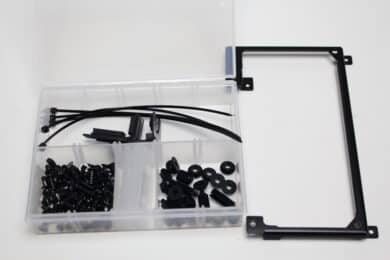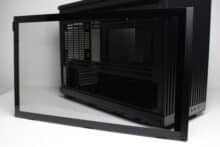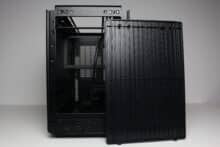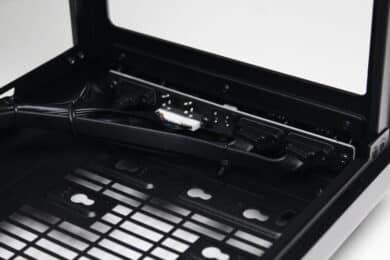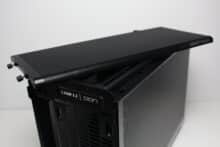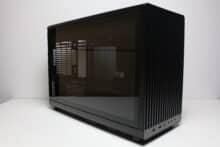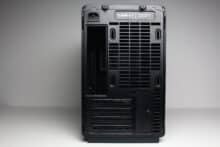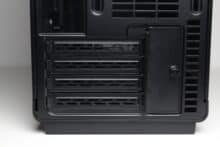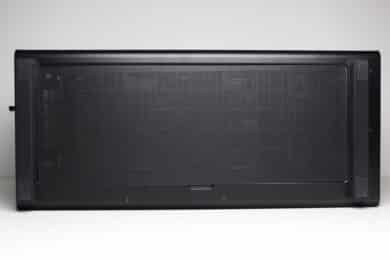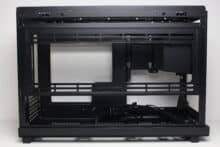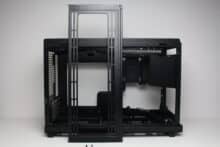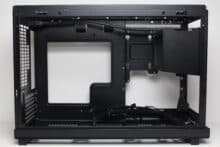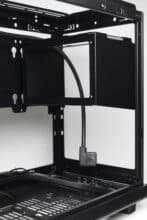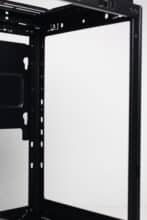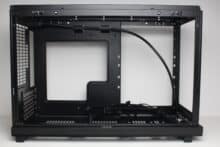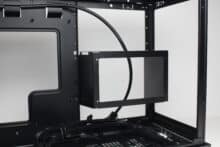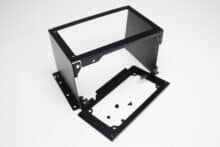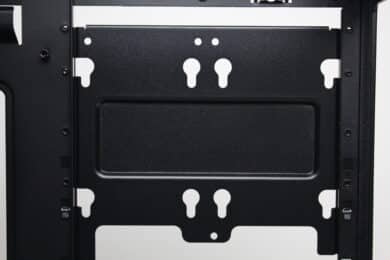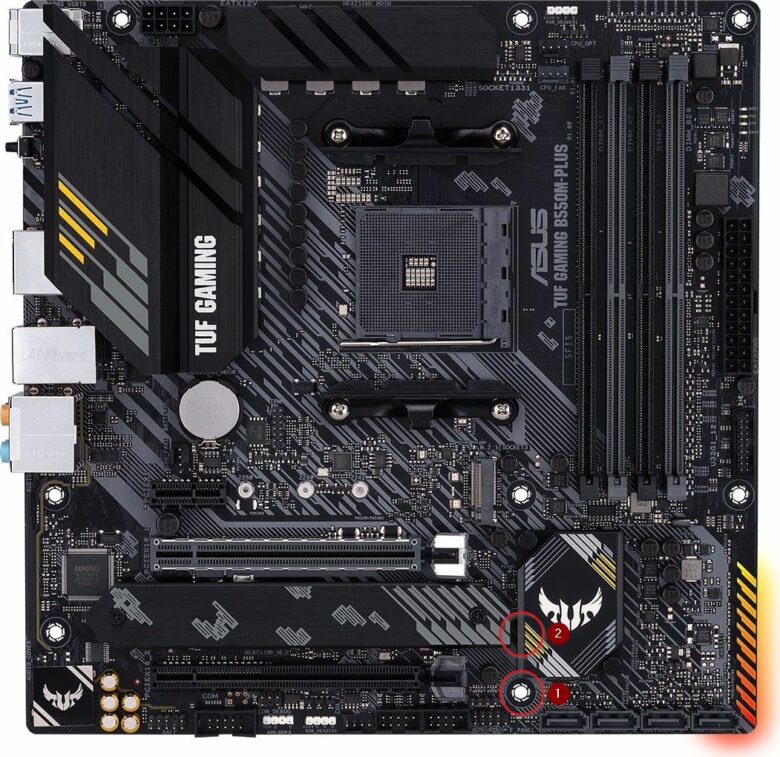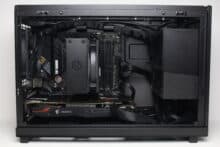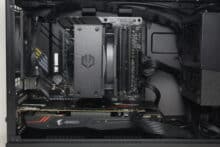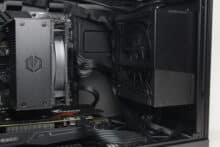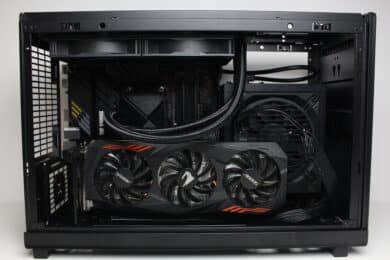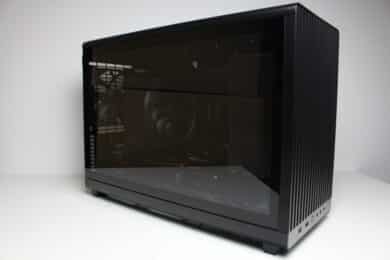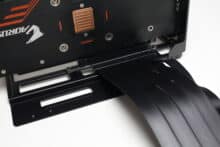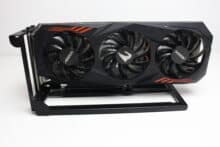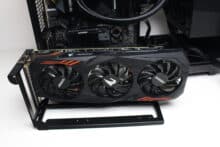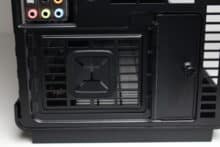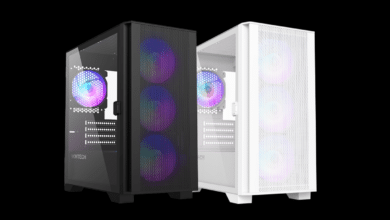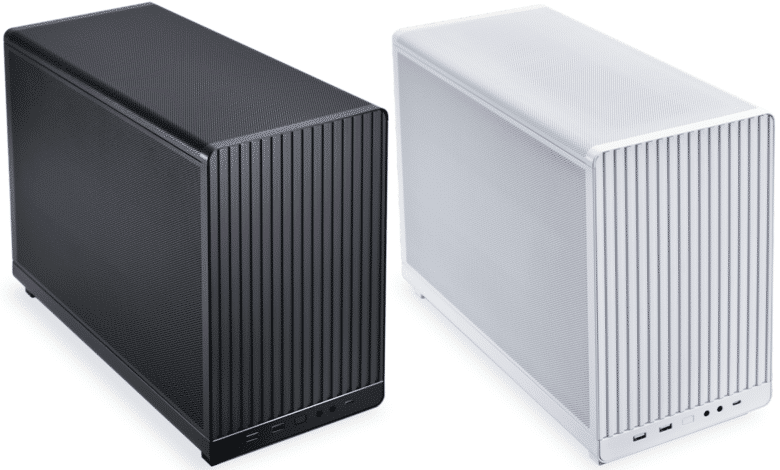
The company DAN Cases was founded in Germany in 2015 and started as a project by a single person. Initially, the manufacturer focused solely on the development of a particularly compact SFF case, which did not yet exist in this form. The developed A4-SFX is now known worldwide and has been a great success. In addition, the Lian Li & DAN A4-H20 is a case that was developed in cooperation with the renowned manufacturer Lian Li. A prototype of the Lian Li & DAN A3-mATX was then presented at the Lian Li Digital Expo 2.0 2022, which even offers space for µATX mainboards and ATX power supplies. We take a closer look at the now officially presented Lian Li & DAN A3-mATX in this test.
In addition to a black version, there is also a white version on offer and the purchase price in both cases is € 69.99 (RRP). Optionally, you can also purchase a tempered glass side window for €12.99 and a PCIe 4.0 riser card for vertical GPU mounting for €49.99.
Technical details
| Model: | Lian Li & DAN A3-mATX |
| Case type: | Mini-Tower |
| Dimensions: | 194 mm (W) x 322 mm (H) x 442 mm (D) |
| Weight: | approx. 4.4 kg |
| Material: | Steel, plastic (optional: tempered glass) |
| Color: | Black |
| Front connections: | 1x USB 3.1 Type-C, 2x USB 3.0 Type-A, 1x headphones, 1x microphone |
| Drive bays: | 1x 3,5″/ 2,5″ 2x 2,5″ |
| Expansion slots: | 4x horizontal (optional: 3x vertical) |
| Form factors: | mATX, ITX |
| Ventilation: | Rear: 1x 120 mm Top: 3x 120 / 2x 140 mm Bottom: 3x 120 / 2x 140 mm Side: 3x 120 / 2x 140 mm |
| Radiators: | Top: 1x 240/ 280/ 360 mm Base: 1x 240/ 280 mm Side: 1x 240/ 280/ 360 mm |
| Max. CPU cooler height: | 167 mm |
| Max. Graphics card length: | 258 mm to 415 mm (depending on power supply length) |
| Max. Power supply length: | 100 mm to 220 mm (depending on graphics card length and mounting position) |
| Price: | € 69.99 (RRP) |
| Special features: | Dust filter, tempered glass (optional), PCIe 4.0 riser card for vertical GPU (optional) |

Lian Li & DAN A3-mATX review: The scope of delivery
The manufacturer packs the A3-mATX in a plain brown cardboard box. The box of our test sample came to us without any printing. However, after consultation with the manufacturer, the A3-mATX comes with printed packaging. As with other cases from Lian Li & DAN, the print reveals little about the case inside. Apart from the manufacturer’s details and the case name, no other technical information can be found on the packaging.
Inside, Lian Li & DAN wraps the A3-mATX in a plastic film and two blocks of normal polystyrene. The polystyrene has a decent thickness and should protect the mini tower very well from damage. All assembly materials are stored in a practical plastic sorting box. It contains all the necessary mounting screws, an offset mounting frame for the power supply unit, some cable ties, rubber rings for mounting the hard disk, a magnetic GPU support, printed assembly instructions and additional dividers for the sorting box.
Lian Li & DAN also offers an optional tempered glass side window and a vertical GPU holder with PCIe 4.0 riser card. The manufacturer packs the already prepared riser card in a white cardboard box and plastic film. The necessary mounting material, a cover for the expansion slots and mounting instructions are also included with the adapter. The side window is also wrapped in cardboard and additional soft foam.
Exterior impression
Visually, the Lian Li & DAN A3-mATX is very restrained and unobtrusive. With a volume of 26.2 liters, it is also very compact for a mini tower.
With a large focus on cooling, the body, which is largely made of steel, is characterized by many ventilation openings and fan slots. Only the front panel is made of plastic and is completely closed. The plastic element is attached with push pins and can be easily removed. Behind it is a large opening and the modular power supply cage.
The manufacturer has also placed the I/O panel at the front. It is equipped with a total of three USB ports (1x USB-C 3.2, 2x USB-A 3.0) as well as a power button and two sockets for headphones and microphone. Good features for a case in this price range.
The lid section of the Lian Li & DAN A3-mATX has also been designed with a focus on good ventilation. It has a large number of round openings, but does not have a dust filter. The corners of the cover plate are slightly rounded, making the A3-mATX appear less bulky. Below the modular cover plate, the manufacturer has installed a mounting frame for three 120 mm or two 140 mm fans. However, the frame is an integral part of the body and cannot be removed.
Both side panels of the A3-mATX are made of steel and have a large mesh grille, which is visually modeled on the openings in the lid. They are attached to the body using steel push pins and plastic holders. Small gripping surfaces on the back of the side panels also allow easy disassembly during assembly. However, you also have to do without dust filters on the side panels. The manufacturer also offers an optional tempered glass side window for the left-hand side. This is slightly tinted in the black version and is also attached using push pins.
The rear of the case has an almost standard appearance for a mini tower. In addition to four expansion slots in the lower area, the cut-out for the I/O shield of the mainboard and an unpopulated mounting space for a 120 mm fan can also be seen. What the A3-mATX lacks at the rear is a mounting position for a power supply unit. Instead, only a socket for the power cable can be seen here.
The A3-mATX has two elongated plastic feet that are attached to the front and rear of the underside and have two rubber strips stuck to them to reduce vibrations. A large ventilation opening with mounting points for up to three 120 mm fans can also be seen here. Finally, the manufacturer has placed a fine mesh filter on top, which can be attached to the underside using magnetic strips.
Interior impression
The interior of the Lian Li & DAN A3-mATX consists of a large main chamber with space for a µATX mainboard, a long 3-slot graphics card and an SFX(-L) or ATX power supply unit. A fan frame for three 120 mm or two 140 mm fans is attached in front of the chamber ex works, which can be opened and removed after loosening two screws. The mainboard tray is flat and has two clips above it for the power supply cable. There are no additional cable management openings or eyelets for cable ties.
As already mentioned, the A3-mATX has an unpopulated fan slot at the rear and four reusable slot brackets that are screwed in from the outside. A modular power supply and SSD frame can be seen in the front area. The base in the interior has a flat design, is equipped with a generous ventilation opening and offers space for three 120 mm fans or two fans and a data carrier.
The main chamber also offers two different mounting points for the modular power supply cage or the SSD mounting frame. Mounting position 1 is located in the front area of the interior, directly behind the front panel, and mounting position 2 is implemented by the manufacturer to the right of the motherboard tray. The SSD frame or the power supply cage can therefore be placed in up to nine different positions. This ensures maximum flexibility.
The rear of the mainboard tray remains unspectacular. There are neither cable management openings nor much space for cables. Except for the initial system assembly, the right side panel will probably never need to be removed again. Nevertheless, the manufacturer has equipped the tray with an opening that allows CPU coolers with backplates to be retrofitted.
The Lian Li & DAN A3-mATX does not offer much space for data carriers. The mini tower has a steel mounting frame to which two 2.5″ SSDs can be attached. Depending on the mounting position of the power supply unit, the steel frame can be attached to the front or to the motherboard tray. The base also has a mounting space for a 3.5″ or 2.5″ data carrier. In this case, however, you would have to do without a 120 mm fan. However, the data carrier mounting is always decoupled.
Processing
The workmanship of the Lian Li & DAN A3-mATX is good, but not at the level we are used to from other Lian Li or DAN cases. The stability of the body is good and the paintwork is largely clean. However, we could see visible scratches on the mainboard tray on our test sample and the mesh side panels make the A3-mATX look a little tinny or rickety when fully assembled.
One last point has less to do with the workmanship, but is nevertheless a flaw that raises certain questions. The manufacturer has simply placed a motherboard standoff in the motherboard tray incorrectly or forgotten it altogether. On standard µATX mainboards, there is a slightly offset hole for the mainboard screw at position “1”. However, the Lian Li & DAN A3-mATX only has a pre-installed spacer at position “2”, which should definitely be removed before installation. Unfortunately, it was not possible to determine whether this was a mistake or a deliberate decision.
Lian Li & DAN A3-mATX test: Installation of the components
Now we come to the system installation for the Lian Li & DAN A3-mATX test. As hardware we use an AMD Ryzen 5 1400* on an ASUS TUF Gaming B550M-Plus* with 16GB Crucial Ballistix Sport LT gray DDR4-2666*. The Ryzen is cooled by an ENDORFY Fera 5 Black* and is overclocked to 3.8 GHz (1.175 V). A Gigabyte AORUS GTX 1060 6GB is responsible for the image output. The power supply is provided by the fully modular LC-Power LC550 V2.31 Platinum*.
The complexity of the assembly and cabling really depends on the components and accessories selected. Our air-cooled test system could be installed and wired very quickly and without any problems. However, when using an ATX power supply unit, this can only be installed in the front and not on the side if the graphics card is installed horizontally and is very long. Depending on the length of the graphics card or the mounting position of the power supply unit, there would even be space for a 360 mm radiator in the lid. However, this should not be thicker than 52 millimeters including the fan if the mainboard has high VRM heat sinks. Alternatively, a 360 mm radiator can also be attached to the side. In this case, however, the power supply unit must not be located in the front.
Thanks to the modular power supply frame, in which both ATX and SFX(-L) power supplies can be mounted and which can be placed in various locations, the internal layout of the Lian Li & DAN A3-mATX allows for many different variants and configurations. In general, there is space for a 167 millimeter high air cooler, a 415 millimeter long graphics card or a 220 millimeter long power supply unit. However, a long power supply unit restricts the maximum length of the graphics card and vice versa. For a better overview, the manufacturer provides comprehensive documentation in which the options are presented in tabular form, among other things.
The installation in conjunction with the optional riser card was much more challenging. If you want to install the GPU vertically, you no longer have the option of mounting a high tower cooler and only have the choice between a low-profile cooler or a compact water cooling system. Depending on the position and length of the GPU, the power supply unit can only be mounted on the side, which in turn limits the size of the compact water cooling system, at least if you opt for an ATX power supply unit.
The optional riser card comes with a large steel mounting frame. Overall, however, the way the riser card is implemented doesn’t really seem well thought out. The frame is simply screwed into the base from below, blocking all the fan slots. In addition, the GPU moves completely into the interior, wasting valuable space and the screen cable always has to be routed inwards via the supplied cover. We would personally advise against purchasing the riser card, as it is neither particularly well implemented nor does it greatly enhance the overall appearance.
Load test
Finally, we come to the temperatures reached in the Lian Li & DAN A3-mATX test. During the stress test, Prime95 and FurMark were run at a room temperature of 20 °C for 30 minutes. For the stress test, we used an air cooler with rear fan and a compact water cooling system.
Scenario |
CPU temperature |
| CPU: 50% PWM (1080 rpm) GPU: 50% PWM (1650 rpm) no case fan Mesh |
CPU: 70.0 °C GPU: 72.5 °C |
| CPU: 50% PWM (1080 rpm) GPU: 50% PWM (1650 rpm) Rear: 1x 120 mm 50% PWM (900 rpm) Mesh |
CPU: 64.0 °C GPU: 70.7 °C |
| CPU: 50% PWM (1080 rpm) GPU: 50% PWM (1650 rpm) Rear: 1x 120 mm 100% PWM (1600 rpm) Mesh |
CPU: 59.7 °C GPU: 69.6 °C |
| CPU: 50% PWM (1080 rpm) GPU: 50% PWM (1650 rpm) no case fan Tempered glass |
CPU: 79.1 °C GPU: 76.8 °C |
| CPU: 50% PWM (1080 rpm) GPU: 50% PWM (1650 rpm) Rear: 1x 120 mm 50% PWM (900 rpm) Tempered glass |
CPU: 66.0 °C GPU: 71.4 °C |
| CPU: 50% PWM (1080 rpm) GPU: 50% PWM (1650 rpm) Rear: 1x 120 mm 100% PWM (1600 rpm) Tempered glass |
CPU: 59.3 °C GPU: 69.0 °C |
Without any case fans, it gets very warm inside the A3-mATX. If the glass side panel is also used, this has a particularly negative effect on the maximum temperature of the CPU. However, if a single fan is installed in the rear, the CPU temperature in particular can be measurably reduced. If several fans are installed, even slightly more powerful hardware should be able to be cooled well in the Lian Li & DAN A3-mATX due to the airflow-friendly design. It is also noticeable that the temperature difference between the mesh panel and tempered glass disappears as the fan speed increases.
We also tested the Lian Li & DAN A3-mATX once with a vertically oriented GPU. However, as there is no more room for an air cooler here, we switched to a compact water cooling system (DeepCool LS520S Zero Dark). The rear fan installed in the previous test was also removed.
Scenario |
Temperature |
| CPU: 50% PWM fan (1430 rpm), 12V pump GPU: 50% PWM (1650 rpm) vertical GPU Mesh |
CPU: 56.2 °C GPU: 69.2 °C |
| CPU: 50% PWM fan (1430 rpm), 12V pump GPU: 50% PWM (1650 rpm) vertical GPU Tempered glass |
CPU: 58.2 °C GPU: 78.3 °C |
The use of compact water cooling has a slightly positive influence on the CPU temperatures despite the lack of a rear fan. The values for a vertical GPU with a mesh panel also show hardly any difference. However, as expected with vertically mounted GPUs, the maximum temperature of the graphics card deteriorates significantly when using the glass window.
Lian Li & DAN A3-mATX test: Conclusion
Particularly compact cases are still very popular, but come with certain limitations and higher costs due to the need for ITX mainboards and SFX power supplies. This is probably why mini towers with a power supply unit in the front are becoming increasingly popular. This is exactly where the Lian Li & DAN A3-mATX comes in and does one thing quite well. It offers a particularly flexible layout in the interior, which also allows the installation of larger components. In addition, the perforations make it very airflow-friendly and it has a modern I/O panel. With a total volume of 26.2 liters, it remains relatively compact and simple, and the purchase price of € 69.99 (RRP) also seems absolutely reasonable compared to the competition.
However, we did not like the A3-mATX’s shortcomings in quality control, which had a negative impact on the overall workmanship of our test model. In addition, the manufacturer did not set the mounting position of a motherboard standoff correctly when designing the case, but still pre-installed the spacer. Should carelessness occur during assembly, this could cause serious damage to the mainboard. Finally, the implementation of the optional riser card seems cumbersome and not very well thought out. However, the latter is not included in the rating for the Lian Li & DAN A3-mATX.
With a recommended retail price of € 69.99, the Lian Li & DAN A3-mATX is exactly where we would expect it to be. One of its biggest competitors is probably the ASUS Prime AP201. However, this mini tower costs a little more, is 7 liters larger and has a less flexible interior layout. However, it offers a little more space for hardware and a fully-fledged cable management system. Overall, the Lian Li & DAN A3-mATX is still a good case to keep in mind. However, we hope that the quality control of the sales version will do a better job and that a version 1.1 with a correct standoff layout will be released soon.
Lian Li & DAN A3-mATX
Workmanship
Structure
Features
Cooling
Value for money
87/100
Despite its compact dimensions, the Lian Li & DAN A3-mATX offers plenty of space and a very flexible layout in the interior. It also has an airflow-friendly but simple design and a modern I/O panel. On the negative side, there are certain shortcomings in terms of workmanship and a missing or incorrectly positioned motherboard stand.






